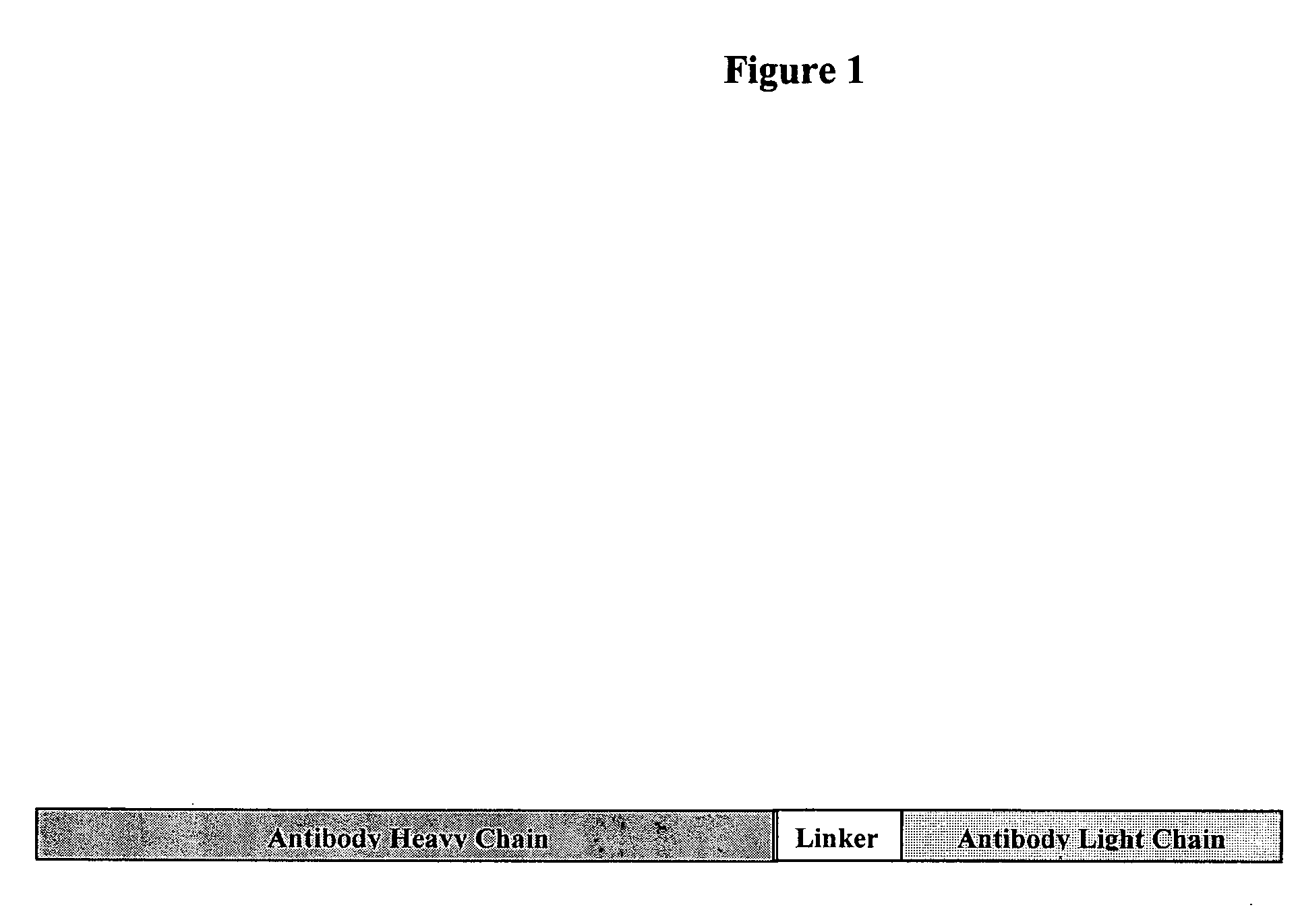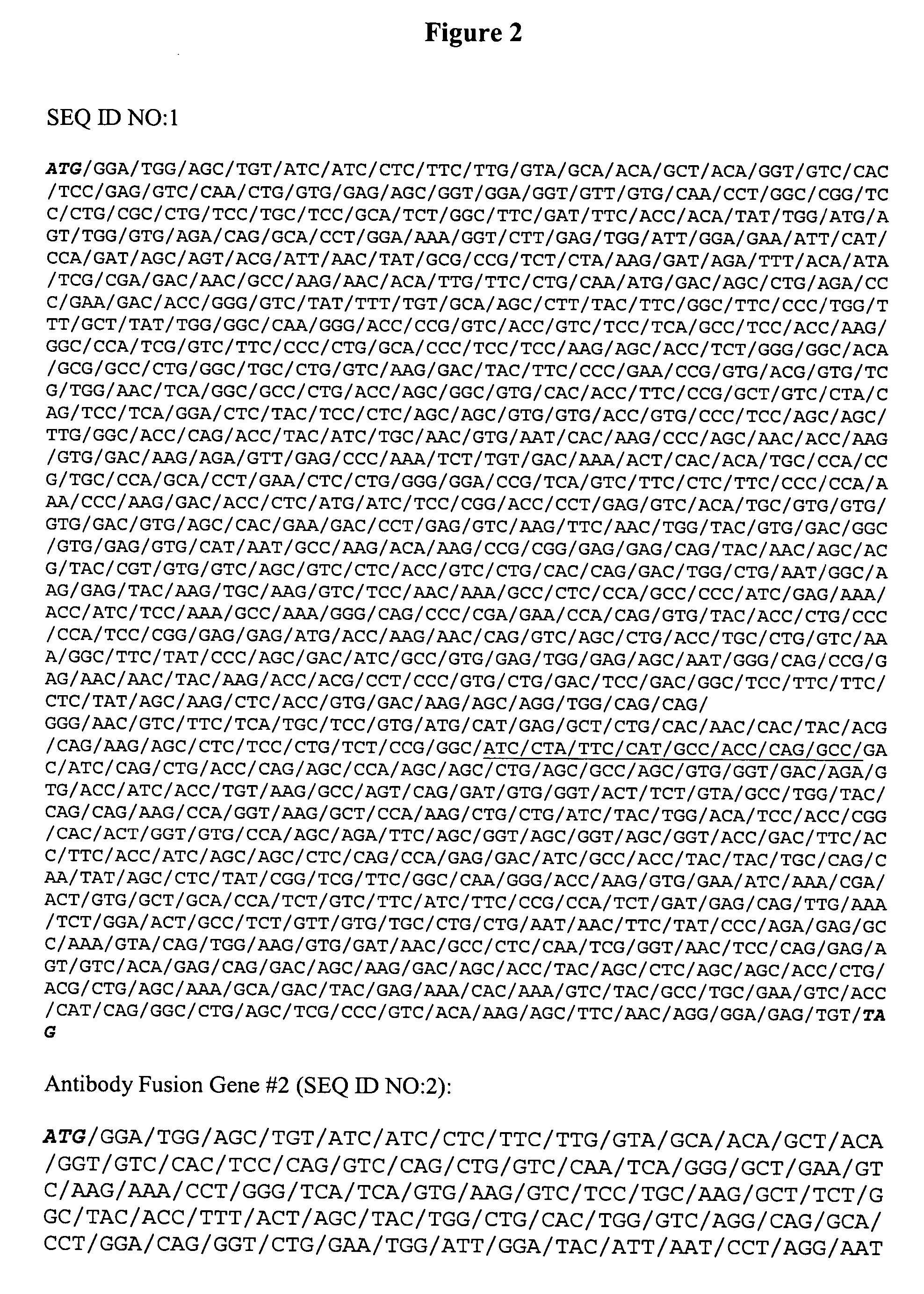Fusion antibodies
a technology of fusion antibodies and antibodies, applied in the field of new antibodies, can solve the problems of high cost of identifying antibodies and producing antibodies, limited number of specific antibodies, and relatively small amount of antibodies
- Summary
- Abstract
- Description
- Claims
- Application Information
AI Technical Summary
Benefits of technology
Problems solved by technology
Method used
Image
Examples
example 1
Generation of Antibody Fusion Genes
[0161] The gene that produces the antibody fusion protein was created as follows: The heavy chain gene of a specific antibody was fused to a linker sequence and the linker sequence was fused to the light chain gene sequence. This fusion gene encodes a single protein. A diagram of the actual gene construct is shown in FIG. 1. The complete sequence of two specific antibody fusions are shown in FIG. 2. The linker sequence is made from a portion of the bovine α-lactalbumin signal peptide. The antibody fusions contain the whole heavy chain gene, but are lacking the last codon, which typically encodes a lysine. The linker gene sequence encodes the following protein sequence: Ile-Leu-Phe-His-Ala-Thr-Gln-Ala. The whole light chain sequence without modifications is then encoded by the fusion gene sequence.
[0162] Cell lines were transduced with retroviral vectors containing the gene constructs. The production of the fusion protein was analyzed via western ...
example 2
Removal of Splice Junction Sequences
[0164] This Example describes the removal of non-canonical splice donor sites of the PSMA heavy chain gene in order to avoid unwanted splicing. The splice site at 5038-5041 of pLNC-PSMAhc-Ires-LC-WPREFixed was mutated from GG GT to CG GG. The mutation was introduced with an oligonucleotide pair (5′ TGAGGCTCTGCACAACCACTACACGCAGAAGAGCCTCTCCCTGTCTCCCGGG AAATGAGAATTCC-3′ (SEQ ID NO:18) and 5′TCGAGGAATTCTCATTTCCCGGGAGACAGGGAGAGGCTCTTCTGCGTGTAG TGGTTGTGC-3′ (SEQ ID NO:19)) that was ligated with pLNC-PSMAhc-Ires-LC-WPREFixed that had been digested with NsiI and XhoI. The sequence of the new clone was verified by sequencing. This construct was shown to successfully produce antibody. The antibody was shown to bind the PSMA antigen.
[0165] The sequences of vectors containing antibody genes in which the splice donor sites have been removed are provided in FIG. 7. These vectors were used to transduce host CHO cells. Media was isolated from clonal populations...
PUM
| Property | Measurement | Unit |
|---|---|---|
| temperature | aaaaa | aaaaa |
| composition | aaaaa | aaaaa |
| nucleic acid | aaaaa | aaaaa |
Abstract
Description
Claims
Application Information
 Login to View More
Login to View More - R&D
- Intellectual Property
- Life Sciences
- Materials
- Tech Scout
- Unparalleled Data Quality
- Higher Quality Content
- 60% Fewer Hallucinations
Browse by: Latest US Patents, China's latest patents, Technical Efficacy Thesaurus, Application Domain, Technology Topic, Popular Technical Reports.
© 2025 PatSnap. All rights reserved.Legal|Privacy policy|Modern Slavery Act Transparency Statement|Sitemap|About US| Contact US: help@patsnap.com



